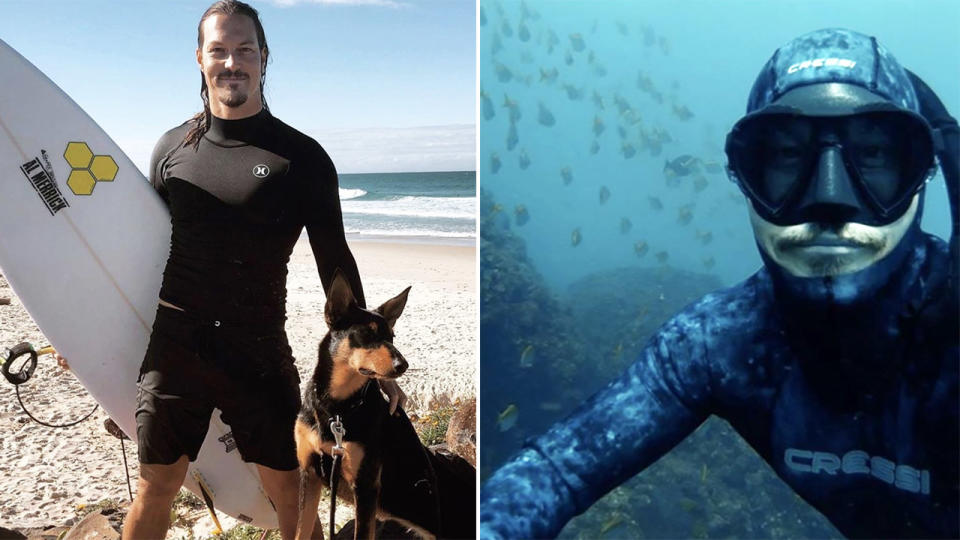Alex 'Chumpy' Pullin death: What is 'shallow water blackout'

As the death of Alex ‘Chumpy’ Pullin continues to cause shockwaves around the world, attention has now turned to the exact circumstances surrounding the Aussie Winter Olympics star’s drowning.
The 32-year-old snowboarder died while spearfishing on an artificial reef off Palm Beach on the Gold Coast on Wednesday morning.
‘CAN’T BELIVE IT’: World reacts to tragic death of ‘Chumpy’
LIGHTNING: Fans erupt over name of Usain Bolt's baby daughter
Police said another diver found Pullin unconscious on the sea floor and pulled him out of the water.
He was wearing a weight belt at the time but wasn’t using an oxygen supply, leading to reports he suffered a “shallow water blackout”.
What exactly is a shallow water blackout?
The term is generally used to describe when someone loses consciousness underwater as a result of holding their breath.
Shallow Water Blackout Prevention says the condition “can affect anyone who is breath-holding, even the physically fit swimmer.
“It is especially seen in competitive swimmers, Navy SEALs, snorkelers, spearfishermen or anyone who free-dives.”
The Medical Journal of Australia describes the condition - also known as “hypoxic blackout” or “apnoeic hypoxia” - as a “distinct and largely preventable cause of drowning”.
Dr Tom Griffiths, a world-leading authority on shallow water blackout, previously said he believes it causes the most drownings among confident swimmers.
“The very competitive Type A personality, if I can say that, the person who pushes themselves to the limit, and see how much longer they can hold their breath or how much further they can go and again that’s a recipe for disaster, particularly if they do it over and over and over again,” he told 60 Minutes in 2018.
“We’ve known about it since the 50s. I’ve only written about it since 1985 and people have only started listening since 2000, so it’s been a long haul.”
According to Royal Life Saving Australia, shallow water blackouts occur when the urge to breathe isn’t reached before someone loses consciousness, or when someone hyperventilates as a result of a lack of oxygen.
“The most common cause is voluntary hyperventilation before submerging,” they wrote previously.
“Hyperventilation, or overbreathing, involves breathing faster and/or deeper than the body requires.
“There are other less common causes, relating to heart abnormalities, which lead to loss of consciousness in the water follow hyperventilation.”
Royal Life Saving Australia further explained how a ‘breakpoint’ will normally force swimmers to take a breath.
“Normally, when a swimmer is trying to stay underwater for as long as possible, the ‘breakpoint’ forces the swimmer to surface and take a breath,” they said.
“If a person is submerged and the ‘breakpoint’ is reached whilst the mouth and nose are still underwater, the irresistible urge to take a breath occurs, and water is inhaled into the lungs.
“This prolonged period may not occur before the oxygen sensor comes into play and the drowning person may lose consciousness underwater.”
Family witnessed tragic resuscitation attempts
On Wednesday police confirmed Pullin was unconscious when he was dragged from the water around 10.40am.
“Another diver was out there and located him on the sea floor and raised the attention of nearby surfers who sought lifeguards to bring him in,” an officer told reporters.
“He didn't have an oxygen mask, we understand he was free diving and spearfishing out on the reef.”
Paramedics and lifeguards performed CPR for about 35 minutes, but he was pronounced dead just before 11.15am.
According to the Courier Mail, Pullin’s girlfriend Ellidy Vlug and her mother arrived at the tragic scene after seeing paramedics on the beach.

They reportedly went down to the beach to see what the commotion was about and witnessed the failed attempts to resuscitate him.
“At the time paramedics were on scene, we were unable to locate anyone who knew the patient, so we just had to treat with the conditions we found,” Queensland Ambulance Service officer Justin Payne said.
“The patient did have water in the lungs which paramedics were suctioning while trying to perform CPR and provide oxygen support.
“There were no other signs of trauma on the patient so we suspect that the patient has succumbed to a drowning event at this time.”
The 32-year-old was the flag-bearer for Australia at the 2014 Winter Olympics in Sochi, Russia.
Pullin, known affectionately as ‘Chumpy’, won world championship titles in 2011 and 2013, and nine World Cup gold medals.
with AAP
